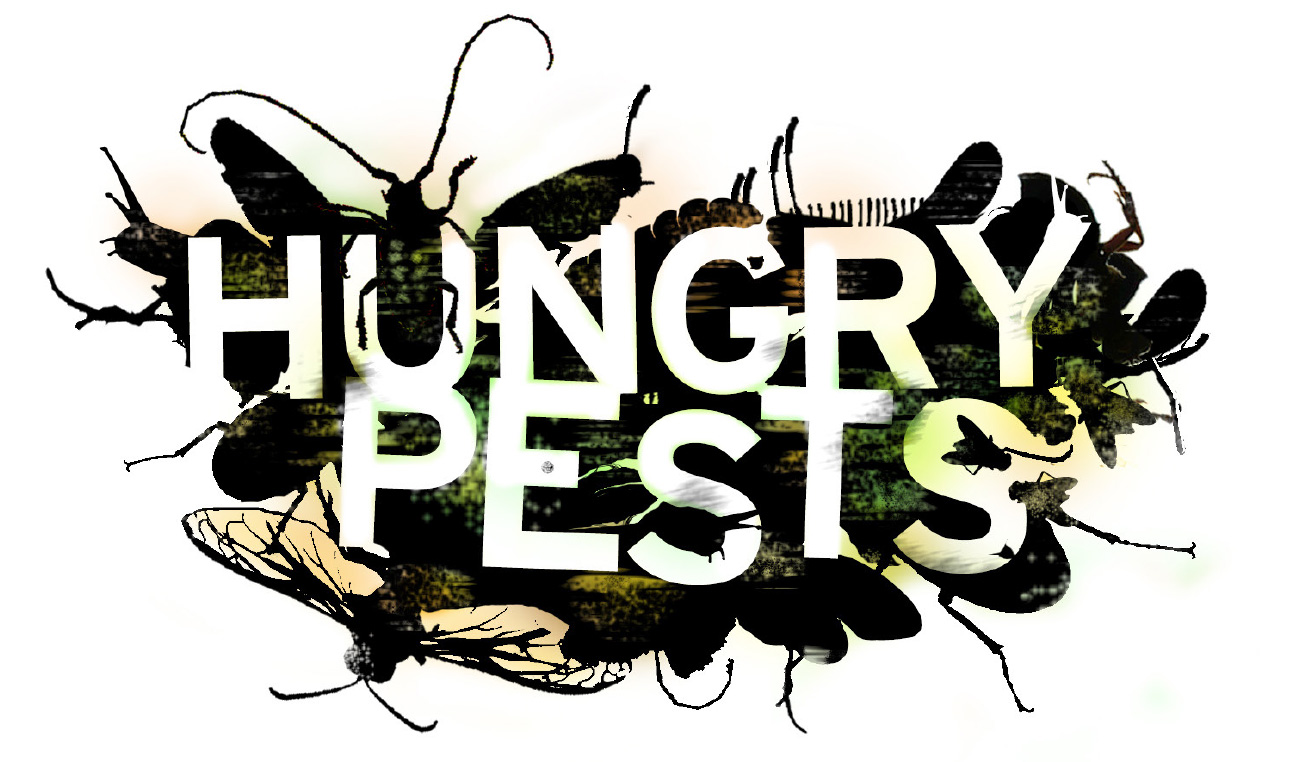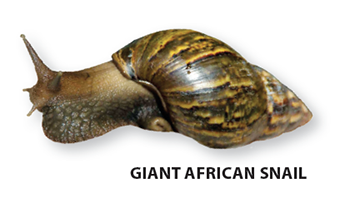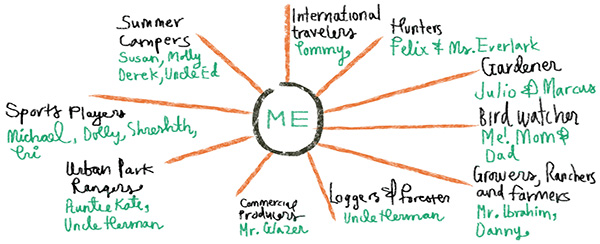Hungry Pests
This lesson teaches about invasive species: what they are, the threats they pose, and damages they can cause. Students will identify individual pests and invasive species and discover what they threaten, where they live, and the pathways hungry pests use to enter new locations. Finally students move into action and explore what they can do to prevent the spread of invasive species.

Background
Lesson Activities
Recommended Companion Resources
Credits
Author
USDA Animal and Plant Health Inspection Service (APHIS) | Animal & Plant Health Inspection Service
Acknowledgements
Hungry Pests Invade Middle School curriculum from the USDA Animal and Plant Health Inspection Service with the following advisors:
Pest Management Group:
- Pest Management Division of USDA’s Animal and Plant Health Inspection Service (APHIS)
- Stephanie Bloem, Entomologist, Risk Analyst, Training Specialist, APHIS
- Heather Curlett, Outreach and Risk Communications Coordinator, APHIS
Teacher Advisory Board:
- Colleen Guertin Parenteau, Science Educator and Sustainability Chair, Shore Country Day School, Massachusetts
- Doug Streblow, Environmental Educator, EarthTeam, California
- Martina McGee, Classroom Teacher, Houston Independent School District, Texas
Standards
Texas Content Area Standards
-
Principles of Agriculture, Food, and Natural Resources: 130.2.c.1
The student demonstrates professional standards/employability skills as required by business and industry. The student is expected to:
- Principles of Agriculture, Food, and Natural Resources: 130.2.c.1.C: demonstrate knowledge of personal and occupational safety, environmental regulations, and first-aid policy in the workplace.
-
Principles of Agriculture, Food, and Natural Resources: 130.2.c.4
The student explains the historical, current, and future significance of the agriculture, food, and natural resources industry. The student is expected to:
- Principles of Agriculture, Food, and Natural Resources: 130.2.c.4.B: analyze the scope of agriculture, food, and natural resources and its effect upon society.
- Principles of Agriculture, Food, and Natural Resources: 130.2.c.4.F: compare and contrast issues impacting agriculture, food, and natural resources such as biotechnology, employment, safety, environment, and animal welfare issues.
-
Principles of Agriculture, Food, and Natural Resources: 130.2.c.6
The student demonstrates appropriate personal and communication skills. The student is expected to:
- Principles of Agriculture, Food, and Natural Resources: 130.2.c.6.A: demonstrate written and oral communication skills appropriate for formal and informal situations such as prepared and extemporaneous presentations.
- Principles of Agriculture, Food, and Natural Resources: 130.2.c.6.B: demonstrate effective listening skills appropriate for formal and informal situations.
-
Principles of Agriculture, Food, and Natural Resources: 130.2.c.15
The student explains the relationship between agriculture, food, and natural resources and the environment. The student is expected to:
- Principles of Agriculture, Food, and Natural Resources: 130.2.c.15.A: determine the effects of agriculture, food, and natural resources upon safety, health, and the environment.
- Principles of Agriculture, Food, and Natural Resources: 130.2.c.15.B: identify regulations relating to safety, health, and environmental systems in agriculture, food, and natural resources.
- Principles of Agriculture, Food, and Natural Resources: 130.2.c.15.C: identify and design methods to maintain and improve safety, health, and environmental systems in agriculture, food, and natural resources.
-
ELA: 7.110.23.b.5
Comprehension skills: listening, speaking, reading, writing, and thinking using multiple texts. The student uses metacognitive skills to both develop and deepen comprehension of increasingly complex texts.
- ELA: 7.110.23.b.5.H: synthesize information to create new understanding
-
Social Studies: 6.113.18.c.19
Social studies skills. The student applies critical-thinking skills to organize and use information acquired through established research methodologies from a variety of valid sources, including technology. The student is expected to:
- Social Studies: 6.113.18.c.19.C: organize and interpret information from outlines, reports, databases, and visuals, including graphs, charts, timelines, and maps
-
Social Studies: 6.113.18.c.21
Social studies skills. The student communicates in written, oral, and visual forms. The student is expected to:
- Social Studies: 6.113.18.c.21.C: express ideas orally based on research and experiences
-
Science: 6.112.26.b.1
Scientific and engineering practices. The student, for at least 40% of instructional time, asks questions, identifies problems, and plans and safely conducts classroom, laboratory, and field investigations to answer questions, explain phenomena, or design solutions using appropriate tools and models. The student is expected to:
- Science: 6.112.26.b.1.A: ask questions and define problems based on observations or information from text, phenomena, models, or investigations
- Science: 6.112.26.b.1.F: construct appropriate tables, graphs, maps, and charts using repeated trials and means to organize data;
- Science: 6.112.26.b.1.H: distinguish between scientific hypotheses, theories, and laws.
-
Social Studies: 6.113.18.c.22
Social studies skills. The student uses problem-solving and decision-making skills, working independently and with others. The student is expected to:
- Social Studies: 6.113.18.c.22.B: use problem-solving and decision-making processes to identify a problem, gather information, list and consider options, consider advantages and disadvantages, choose and implement a solution, and evaluate the effectiveness of the solution
-
Science: 6.112.26.b.3
Scientific and engineering practices. The student develops evidence-based explanations and communicates findings, conclusions, and proposed solutions. The student is expected to:
- Science: 6.112.26.b.3.A: develop explanations and propose solutions supported by data and models and consistent with scientific ideas, principles, and theories;
- Science: 6.112.26.b.3.B: communicate explanations and solutions individually and collaboratively in a variety of settings and formats; and
-
Science: 6.112.26.b.4
Scientific and engineering practices. The student knows the contributions of scientists and recognizes the importance of scientific research and innovation on society. The student is expected to:
- Science: 6.112.26.b.4.C: research and explore resources such as museums, libraries, professional organizations, private companies, online platforms, and mentors employed in a science, technology, engineering, and mathematics (STEM) field to investigate STEM careers.
-
Science: 6.112.26.b.5
Recurring themes and concepts. The student understands that recurring themes and concepts provide a framework for making connections across disciplines. The student is expected to:
- Science: 6.112.26.b.5.A: identify and apply patterns to understand and connect scientific phenomena or to design solutions;
-
Social Studies: 7.113.19.c.20
Social studies skills. The student applies critical-thinking skills to organize and use information acquired through established research methodologies from a variety of valid sources, including technology. The student is expected to:
- Social Studies: 7.113.19.c.20.C: organize and interpret information from outlines, reports, databases, and visuals, including graphs, charts, timelines, and maps
-
Social Studies: 7.113.19.c.23
Social studies skills. The student uses problem-solving and decision-making skills, working independently and with others. The student is expected to:
- Social Studies: 7.113.19.c.23.B: use problem-solving and decision-making processes to identify a problem, gather information, list and consider options, consider advantages and disadvantages, choose and implement a solution, and evaluate the effectiveness of the solution
-
Science: 6.112.26.b.12
Organisms and environments. The student knows that interdependence occurs between living systems and the environment. The student is expected to:
- Science: 6.112.26.b.12.B: describe and give examples of predatory, competitive, and symbiotic relationships between organisms, including mutualism, parasitism, and commensalism;
-
Science: 6.112.26.b.13
Organisms and environments. The student knows that organisms have an organizational structure and variations can influence survival of populations. The student is expected to:
- Science: 6.112.26.b.13.C: describe how variations within a population can be an advantage or disadvantage to the survival of a population as environments change
-
Social Studies: 8.113.20.c.29
Social studies skills. The student applies critical-thinking skills to organize and use information acquired through established research methodologies from a variety of valid sources, including technology. The student is expected to:
- Social Studies: 8.113.20.c.29.C: organize and interpret information from outlines, reports, databases, and visuals, including graphs, charts, timelines, and maps
-
Social Studies: 8.113.20.c.31
Social studies skills. The student uses problem-solving and decision-making skills, working independently and with others. The student is expected to:
- Social Studies: 8.113.20.c.31.B: use problem-solving and decision-making processes to identify a problem, gather information, list and consider options, consider advantages and disadvantages, choose and implement a solution, and evaluate the effectiveness of the solution
-
Science: 7.112.27.b.1
Scientific and engineering practices. The student, for at least 40% of instructional time, asks questions, identifies problems, and plans and safely conducts classroom, laboratory, and field investigations to answer questions, explain phenomena, or design solutions using appropriate tools and models. The student is expected to:
- Science: 7.112.27.b.1.A: ask questions and define problems based on observations or information from text, phenomena, models, or investigations;
- Science: 7.112.27.b.1.F: construct appropriate tables, graphs, maps, and charts using repeated trials and means to organize data
- Science: 7.112.27.b.1.H: distinguish between scientific hypotheses, theories, and laws.
-
Science: 7.112.27.b.3
Scientific and engineering practices. The student develops evidence-based explanations and communicates findings, conclusions, and proposed solutions. The student is expected to:
- Science: 7.112.27.b.3.A: develop explanations and propose solutions supported by data and models and consistent with scientific ideas, principles, and theories;
- Science: 7.112.27.b.3.B: communicate explanations and solutions individually and collaboratively in a variety of settings and formats; and
-
Science: 7.112.27.b.4
Scientific and engineering practices. The student knows the contributions of scientists and recognizes the importance of scientific research and innovation on society. The student is expected to:
- Science: 7.112.27.b.4.C: research and explore resources such as museums, libraries, professional organizations, private companies, online platforms, and mentors employed in a science, technology, engineering, and mathematics (STEM) field to investigate STEM careers
-
Science: 7.112.27.b.5
Recurring themes and concepts. The student understands that recurring themes and concepts provide a framework for making connections across disciplines. The student is expected to:
- Science: 7.112.27.b.5.A: identify and apply patterns to understand and connect scientific phenomena or to design solutions;
-
Science: 7.112.27.b.14
Organisms and environments. The student knows how the taxonomic system is used to describe relationships between organisms. The student is expected to:
- Science: 7.112.27.b.14.A: describe the taxonomic system that categorizes organisms based on similarities and differences shared among groups; and
-
Science: 8.112.28.b.1
Scientific and engineering practices. The student, for at least 40% of instructional time, asks questions, identifies problems, and plans and safely conducts classroom, laboratory, and field investigations to answer questions, explain phenomena, or design solutions using appropriate tools and models. The student is expected to:
- Science: 8.112.28.b.1.A: ask questions and define problems based on observations or information from text, phenomena, models, or investigations;
- Science: 8.112.28.b.1.F: construct appropriate tables, graphs, maps, and charts using repeated trials and means to organize data;
- Science: 8.112.28.b.1.H: distinguish between scientific hypotheses, theories, and laws.
-
Science: 8.112.28.b.3
Scientific and engineering practices. The student develops evidence-based explanations and communicates findings, conclusions, and proposed solutions. The student is expected to:
- Science: 8.112.28.b.3.A: develop explanations and propose solutions supported by data and models and consistent with scientific ideas, principles, and theories;
- Science: 8.112.28.b.3.B: communicate explanations and solutions individually and collaboratively in a variety of settings and formats; and
-
Science: 8.112.28.b.4
Scientific and engineering practices. The student knows the contributions of scientists and recognizes the importance of scientific research and innovation on society. The student is expected to
- Science: 8.112.28.b.4.C: research and explore resources such as museums, libraries, professional organizations, private companies, online platforms, and mentors employed in a science, technology, engineering, and mathematics (STEM) field to investigate STEM careers.
-
Science: 8.112.28.b.5
Recurring themes and concepts. The student understands that recurring themes and concepts provide a framework for making connections across disciplines. The student is expected to:
- Science: 8.112.28.b.5.A: identify and apply patterns to understand and connect scientific phenomena or to design solutions;
-
Science: 8.112.28.b.10
Earth and space. The student knows that interactions between Earth, ocean, and weather systems impact climate. The student is expected to:
- Science: 8.112.28.b.10.A: describe how energy from the Sun, hydrosphere, and atmosphere interact and influence weather and climate;
- Science: 8.112.28.b.10.B: identify global patterns of atmospheric movement and how they influence local weather; and
- Science: 8.112.28.b.10.C: describe the interactions between ocean currents and air masses that produce tropical cyclones, including typhoons and hurricanes.
-
Science: 8.112.28.b.11
Earth and space. The student knows that natural events and human activity can impact global climate. The student is expected to:
- Science: 8.112.28.b.11.B: use scientific evidence to describe how human activities, including the release of greenhouse gases, deforestation, and urbanization, can influence climate; and
- Science: 8.112.28.b.11.C: describe the carbon cycle.
-
Science: 8.112.28.b.12
Organisms and environments. The student understands stability and change in populations and ecosystems. The student is expected to:
- Science: 8.112.28.b.12.A: explain how disruptions such as population changes, natural disasters, and human intervention impact the transfer of energy in food webs in ecosystems;
- Science: 8.112.28.b.12.B: describe how primary and secondary ecological succession affect populations and species diversity after ecosystems are disrupted by natural events or human activity; and
- Science: 8.112.28.b.12.C: describe how biodiversity contributes to the stability and sustainability of an ecosystem and the health of the organisms within the ecosystem.
-
ELA: 6.110.22.b.5
Comprehension skills: listening, speaking, reading, writing, and thinking using multiple texts. The student uses metacognitive skills to both develop and deepen comprehension of increasingly complex texts. The student is expected to:
- ELA: 6.110.22.b.5.H: synthesize information to create new understanding
-
ELA: 6.110.22.b.6
Response skills: listening, speaking, reading, writing, and thinking using multiple texts. The student responds to an increasingly challenging variety of sources that are read, heard, or viewed. The student is expected to:
- ELA: 6.110.22.b.6.C: use text evidence to support an appropriate response
- ELA: 6.110.22.b.6.H: respond orally or in writing with appropriate register, vocabulary, tone, and voice
-
ELA: 6.110.22.b.9
Author's purpose and craft: listening, speaking, reading, writing, and thinking using multiple texts. The student uses critical inquiry to analyze the authors' choices and how they influence and communicate meaning within a variety of texts. The student analyzes and applies author's craft purposefully in order to develop his or her own products and performances. The student is expected to:
- ELA: 6.110.22.b.9.A: explain the author's purpose and message within a text
-
ELA: 6.110.22.b.11
Composition: listening, speaking, reading, writing, and thinking using multiple texts--genres. The student uses genre characteristics and craft to compose multiple texts that are meaningful. The student is expected to:
- ELA: 6.110.22.b.11.D: compose correspondence that reflects an opinion, registers a complaint, or requests information in a business or friendly structure
-
ELA: 7.110.23.b.6
Response skills: listening, speaking, reading, writing, and thinking using multiple texts. The student responds to an increasingly challenging variety of sources that are read, heard, or viewed. The student is expected to:
- ELA: 7.110.23.b.6.C: use text evidence to support an appropriate response
- ELA: 7.110.23.b.6.H: respond orally or in writing with appropriate register, vocabulary, tone, and voice
-
ELA: 7.110.23.b.9
Author's purpose and craft: listening, speaking, reading, writing, and thinking using multiple texts. The student uses critical inquiry to analyze the authors' choices and how they influence and communicate meaning within a variety of texts. The student analyzes and applies author's craft purposefully in order to develop his or her own products and performances. The student is expected to:
- ELA: 7.110.23.b.9.A: explain the author's purpose and message within a text
-
ELA: 7.110.23.b.11
Composition: listening, speaking, reading, writing, and thinking using multiple texts--genres. The student uses genre characteristics and craft to compose multiple texts that are meaningful. The student is expected to:
- ELA: 7.110.23.b.11.D: compose correspondence that reflects an opinion, registers a complaint, or requests information in a business or friendly structure
-
ELA: 8.110.24.b.5
Comprehension skills: listening, speaking, reading, writing, and thinking using multiple texts. The student uses metacognitive skills to both develop and deepen comprehension of increasingly complex texts. The student is expected to:
- ELA: 8.110.24.b.5.H: synthesize information to create new understanding
-
ELA: 8.110.24.b.6
Response skills: listening, speaking, reading, writing, and thinking using multiple texts. The student responds to an increasingly challenging variety of sources that are read, heard, or viewed. The student is expected to:
- ELA: 8.110.24.b.6.C: use text evidence to support an appropriate response
- ELA: 8.110.24.b.6.H: respond orally or in writing with appropriate register, vocabulary, tone, and voice
-
ELA: 8.110.24.b.9
Author's purpose and craft: listening, speaking, reading, writing, and thinking using multiple texts. The student uses critical inquiry to analyze the authors' choices and how they influence and communicate meaning within a variety of texts. The student analyzes and applies author's craft purposefully in order to develop his or her own products and performances. The student is expected to:
- ELA: 8.110.24.b.9.A: explain the author's purpose and message within a text
-
ELA: 8.110.24.b.11
Composition: listening, speaking, reading, writing, and thinking using multiple texts--genres. The student uses genre characteristics and craft to compose multiple texts that are meaningful. The student is expected to:
- ELA: 8.110.24.b.11.D: compose correspondence that reflects an opinion, registers a complaint, or requests information in a business or friendly structure
-
Technology Applications: 126.17.c.1
Computational thinking--foundations. The student explores the core concepts of computational thinking, a set of problem-solving processes that involve decomposition, pattern recognition, abstraction, and algorithms. The student is expected to:
- Technology Applications: 126.17.c.1.A: decompose real-world problems into structured parts by using visual representation
- Technology Applications: 126.17.c.1.B: analyze the patterns and sequences found in visual representations such as learning maps, concept maps, or other representations of data
-
Technology Applications: 126.18.c.1
Computational thinking--foundations. The student explores the core concepts of computational thinking, a set of problem-solving processes that involve decomposition, pattern recognition, abstraction, and algorithms. The student is expected to:
- Technology Applications: 126.18.c.1.A: decompose real-world problems into structured parts using flowcharts
- Technology Applications: 126.18.c.1.B: analyze the patterns and sequences found in flowcharts
 Introduce the concept of invasive species to students by having them draw upon existing knowledge about pests from real-world experience or previous units/lessons. Post the following questions on chart paper around the room:
Introduce the concept of invasive species to students by having them draw upon existing knowledge about pests from real-world experience or previous units/lessons. Post the following questions on chart paper around the room:







